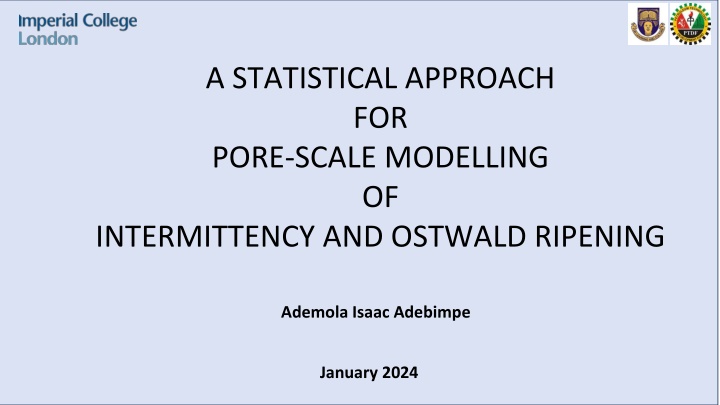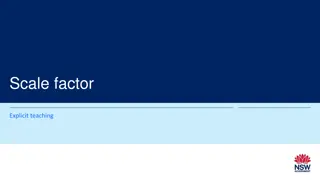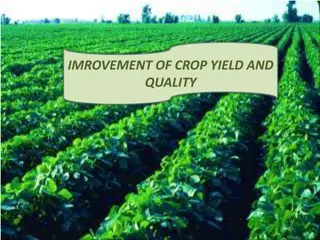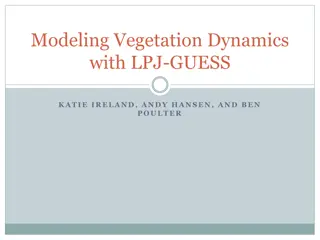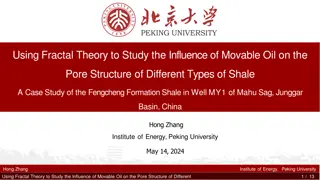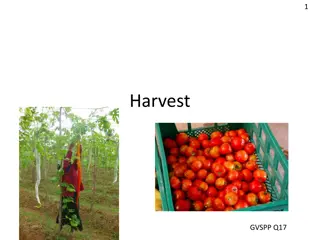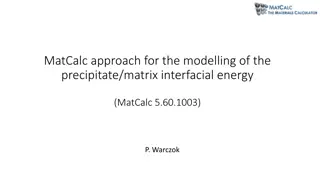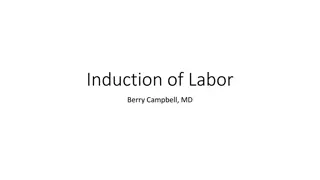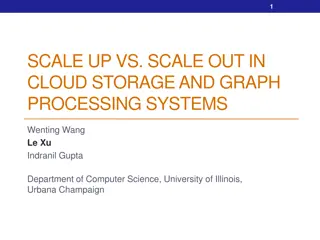Statistical Modeling of Pore-Scale Intermittency and Ostwald Ripening
Using a statistical approach, this research delves into the pore-scale modeling of intermittency and Ostwald ripening in two-phase flows. The study challenges the traditional linear relationship between pressure gradient and capillary number, highlighting the impact of fluid intermittency on flow behavior. Experimental results and modeling techniques are presented, shedding light on how non-wetting phases navigate conductive pathways in porous media. The methodology for simulating fluid intermittency is detailed, along with simulation results that provide insights into this complex phenomenon.
Download Presentation

Please find below an Image/Link to download the presentation.
The content on the website is provided AS IS for your information and personal use only. It may not be sold, licensed, or shared on other websites without obtaining consent from the author.If you encounter any issues during the download, it is possible that the publisher has removed the file from their server.
You are allowed to download the files provided on this website for personal or commercial use, subject to the condition that they are used lawfully. All files are the property of their respective owners.
The content on the website is provided AS IS for your information and personal use only. It may not be sold, licensed, or shared on other websites without obtaining consent from the author.
E N D
Presentation Transcript
A STATISTICAL APPROACH FOR PORE-SCALE MODELLING OF INTERMITTENCY AND OSTWALD RIPENING Ademola Isaac Adebimpe January 2024
Fluid intermittency during two-phase flow Capillary number for two-phase flow: Extended Darcy s law for two-phase flow: ?? ? ?? = ?? = ? ?? ?? ?? ? 1 ?1 ?2 +?1 ? ?? ?1 Traditional expectation/knowledge is that there is always a linear relationship between pressure gradient and capillary number. Recent experimental findings have shown that the relationship between pressure gradient and capillary number is not always linear; (major research groups establishing this being Tallakstad and co- researchers; Hansen and co-researchers; Blunt and co-researchers).
Fluid intermittency during two-phase flow ?? Ca Expected ?? ??? Observed Fluid intermittency is caused by the nonwetting phase periodically finding more conductive pathways through the pore space, usually when the viscous force becomes comparable to the capillary forces. Areas of the pore space exhibiting intermittent flow behavior were detected from their scan s greyscale value. Intermittent flow pathways could provide significant connectivity for seemly trapped nonwetting phase clusters, altering relative permeabilities and how much is trapped. Thus, it is of relevance to applications of subsurface flow.
Experimental Results on Intermittency ?? ??= ??+ ??? phase 1: wetting (w) phase 2: non-wetting (nw) Zhang et al., 2021
Modelling of Fluid Intermittency = ? ???( ?? ?) Can two-phase intermittency behavior be simulated using a statistical thermodynamic approach? ?? z = ?? ???( ?? ?)+ 1 ?? ???( ?? ??= ?.??? ?? ?) ??= ?? ?.??? ???= Entry capillary pressure for drainage ???= Entry capillary pressure for imbibition ?? = Prevailing capillary pressure ? = Agiture (a measure of agitation), unit of Pa ? = Tuning parameter
Methodology for Implementing Model Simulate quasi-static drainage to the desired residual wetting phase saturation A quasi static code to simulate drainage and imbibition was written in Python and validated with experimental data and a previous model. Simulate quasi-static imbibition to the desired fractional flow Implement the model at that fractional flow
Ostwald Ripening Ostwald ripening refers to diffusion-driven transport to eliminate concentration gradients in the aqueous phase. Differences in local capillary pressure of trapped ganglia result in differences in the gas pressure and consequently lead to concentration gradients in the aqueous phase https://youtu.be/REcr2l7miVg?list=PL4AOcbv0op0RYx5ktcI2xijiSPRFUDkB2 Ostwald ripening leads to the growth of low- pressure ganglia and the shrinkage, if not complete disappearance of higher- pressure ganglia.
Modelling of Ostwald ripening There are existing Ostwald ripening models: Li and Yortsos (1995); Dominguez et al. (2000) 2D models, modelled bubble growth as an invasion percolation process, pressure-volume relations. de Chalendar et al. (2017) 3D model (using maximal ball algorithm), sequential algorithm (phenomenon decoupled into two processes), mass balance equations. Mehmani and Xu (2022) 2D model, fully-implicit algorithm, mass balance equations. Can Ostwald ripening phenomenon be simulated using a statistical mechanical approach? Our propositions: Model bubble growth as an invasion percolation process (drainage). Model bubble shrinkage as a percolation process (imbibition). Devise a means of including time-dependency.
Methodology for Implementing Model Simulate several cycles of drainage and imbibition using a modified version of the quasi-static code Here, the trapping of gas ganglia/clusters are tracked as done in the quasi-static code. However, the modifications include: Drainage simulation Allowing the filling of pores and throats even if trapped in imbibition, this leads to ganglia shrinkage/disappearance. Allowing neighboring pores and throats to the ganglia to be filled with the non-wetting phase during drainage, this leads to ganglia growth. Imbibition simulation
Future Works A. Fluid Intermittency model Full development of the Intermittency model. Study of the impact of geometry (sandstones and carbonates) on fluid intermittency. Study of the impact of wettability on fluid intermittency. B. Ostwald ripening model Full development of the Ostwald ripening model Study of time dependency of Ostwald ripening Study of impact of wettability and geometry on Ostwald ripening.
References P. H. Valvatne and M. J. Blunt, Predictive pore-scale modeling of two-phase flow in mixed wet media, Water resources research, vol. 40, no. 7, 2004. Y. Gao, Q. Lin, B. Bijeljic, and M. J. Blunt, Pore-scale dynamics and the multiphase darcy law, Physical Review Fluids, vol. 5, no. 1, p. 013 801, 2020. M. J. Blunt, Multiphase flow in permeable media: A pore-scale perspective. Cambridge university press, 2017. C. Spurin, T. Bultreys, B. Bijeljic, M. J. Blunt, and S. Krevor, Intermittent fluid connectivity during two-phase flow in a heterogeneous carbonate rock, Physical Review E, vol. 100, no. 4, p. 043 103, 2019. Y. Zhang, B. Bijeljic, Y. Gao, Q. Lin, and M. J. Blunt, Quantification of nonlinear multiphase flow in porous media, Geophysical Research Letters, vol. 48, no. 5, e2020GL090477, 2021. K. T. Tallakstad, G. L voll, H. A. Knudsen, T. Ramstad, E. G. Flekk y, and K. J. M al y, Steady-state, simultaneous two-phase flow in porous media: An experimental study, Physical Review E, vol. 80, no. 3, p. 036 308, 2009. A. Hansen, E. G. Flekk y, S. Sinha, and P. A. Slotte, A statistical mechanics framework for immiscible and incompressible two-phase flow in porous media, Advances in Water Resources, vol. 171, p. 104 336, 2023. H. Fyhn, S. Sinha, and A. Hansen, Local statistics of immiscible and incompressible two-phase flow in porous media, Physica A: Statistical Mechanics Mechanics and its Applications, vol. 616, p. 128 626, 2023. B. Raeesi, N. R. Morrow, and G. Mason, Capillary pressure hysteresis behavior of three sandstones measured with a multistep outflow inflow apparatus, Vadose Zone Journal, vol. 13, no. 3, 2014. M. J., Blunt Ostwald ripening and gravitational equilibrium: Implications for long-term subsurface gas storage. Physical Review E, 2022, 106(4): 45-103. de Chalendar, J. A., Garing, C. & Benson, S. M. 2017 Pore-scale considerations on Ostwald ripening in rocks. Energy Proc. 114C, 484 489. Y. Mehmani, K. Xu 2022 Pore-network modeling of Ostwald ripening in porous media: how do trapped bubbles equilibrate? J. Comput. Phys., 457 (2022), Article 111041. N.S. Muhammed, B. Haq, D. Al Shehri, A. Al-Ahmed, M.M. Rahman, E. Zaman. 2022 A review on underground hydrogen storage: insight into geological sites, influencing factors and future outlook Energy Rep, 8 (2022), pp. 461-499. Li, X. and Yortsos, Y.C. 1995. Theory of multiple bubble growth in porous media by solute diffusion. Chemical Engineering Science, 50, 1247-1271. A. Dominguez, S. Bories & M. Prat 2000 Gas cluster growth by solute diffusion in porous media. Experiments and automaton simulation on pore network. Intl J. Multiphase Flow 26 (12), 1951 1979.
Questions/Discussions For suggestions, comments and questions: a.adebimpe21@imperial.ac.uk
